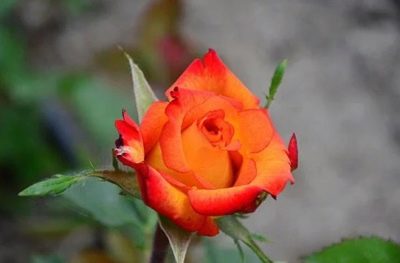
- Authors: Interplant HT
- Name synonyms: High Society, Interhiety
- Breeding year: 2005
- Group: tea-hybrid
- The main color of the flower: yellow
- Flower shape: classic goblet with high center
- Flower size: large
- Diameter, cm: 10-12
- Flower type by number of petals: thick double
- Description of the bush: short, compact
In 2005, the variety was introduced to the Netherlands for the first time. Its author is Interplant HT. Rose Upper Light is known to gardeners under other names: High Society, Interhiety.
Description of the variety
Rose Upper Light belongs to the hybrid tea group. The variety is intended for growing in flower beds and cutting. The plant is a double-colored double-colored flower. The outer bright yellow petals are bordered by a wide red edging located at the edge. The petal substrate has a yellow tint. The plant has large dark green foliage with a glossy sheen.
The rose resembles the classic shape of a large, elegant glass. The diameter of an open flower is 10-12 cm. A spectacular rose with a high center has sufficient density. The bud contains up to 40 petals.
Rose has a faint but wondrous scent. Large flowers are placed on a compact bush, the height of which can be from 60 to 100 cm. The stems grow straight without bending under the weight of the buds. With good care, the diameter of the bush reaches 60 cm.
Advantages and disadvantages
The pluses include the neatness of the bush, the extraordinary beauty of luxurious roses, the duration of flowering. The flowers stay on the bush for a long time, and in the cut they stand for 2 weeks. During this time, cut roses retain their fresh and elegant look.
The disadvantage is the possibility of plant death in a snowless frosty winter.
Flowering features
The rose of this variety blooms profusely throughout the summer until the onset of frost. It has the property of re-flowering. Lush roses bloom almost continuously. The gap between flowering cycles is small. The rose emerges from a beautiful bud on an elastic shoot. The bud opens slowly. Usually there is only 1 flower on a strong stem. Inflorescences are rare.
Use in landscape design
With the help of delightful roses, Upper society creates a harmonious landscape design of garden and backyard plots. The variety fits perfectly into a flower bed with single and group plantings. The bush can be made the centerpiece of any flower garden. It looks good in the neighborhood with other varieties of roses in a contrasting color.
Growing regions
The plant loves warmth, but tolerates winter well. It belongs to the 6th zone of frost resistance (USDA), when the temperature can range from -23 ° C to -18 ° C. The climate of Krasnodar Territory, Crimea, Caucasus, Ukraine is ideal for growing this culture.
Landing
Planting the variety is best done in May. It is important to choose a well-lit flower bed with well-drained, fertile soil. The size of the pit should be 50 cm. Immediately after planting, shoots should be left no more than 45 cm. The seedlings take root in a new place after 20-25 days.
Growing and caring
The plant is intended for outdoor cultivation. The correct development of the bush occurs with regular and shallow loosening, weeding in the near-trunk circle and hilling with soil mixture.
Watering and feeding
The survival rate of seedlings in a new place depends on watering. The young bush is moistened to a depth of root ends (40-45 cm). Watering requires a bucket of water, and in the dry season - 2 buckets.During the first month after planting, the plant is watered at least 2 times a week.
In order for the soil to retain moisture longer, organic mulching with a layer of 7-10 cm around the trunk is necessary. In early spring, the plant is recommended to be sprayed with a preparation containing copper. Mineral and organic feeding is carried out 1 time in 2 weeks.
Pruning
Timely pruning of seedlings in the first weeks affects the survival rate of young shrubs. Spring pruning plays an important role. A plant planted in autumn should be pruned at the same time as the cover is removed.
Frost resistance and preparation for winter
The variety can withstand air temperatures down to -23 ° C. But a winter-hardy rose must be prepared for wintering. You can completely close the bush after a stable negative air temperature has been established. First, young branches and leaves are cut off, and also unripe buds are disposed of. The remaining stems are collected in a bunch and treated with a solution of three percent ferrous sulfate. Then sprinkle the base of the bush with dry soil. After that, the plant is wrapped in a separate covering material. Spruce branches serve as a good shelter.
Diseases and pests
The variety is resistant to various diseases. The plant has an average level of resistance to black spot, and to powdery mildew - above average. Rose Upper Light steadfastly endures the abundance of aphids.
Review overview
Gardeners note that the flowering bush emits a special light in the dark. It looks like a bright orange-yellow light with red blotches.































































